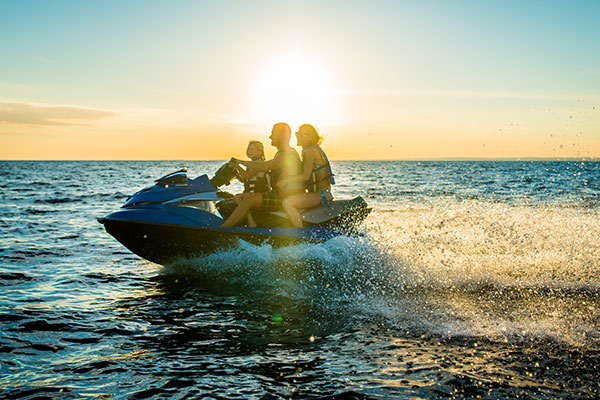Personal watercrafts (PWCs) are undeniably fun—which is one of the reasons that you can find them almost anywhere there’s a body of water.
That fact—and the small size of these vessels—can give the impression that they’re easy to drive safely. However, PWCs—vessels propelled by a water-jet pump and driven by someone sitting, standing or kneeling on the machine—can be tricky to operate. The combination of high-speed capability (they can exceed 65 mph) and extreme maneuverability (which can make their direction unpredictable to other boaters) puts them at risk for accidents.
In fact, according to BoatUS, PWCs are over-represented in accident statistics, with nearly 20 percent of all reported boating accidents attributed to them. Almost 25 percent of boating injuries take place on PWCs each year.
One of the main reasons? Inexperience. As explained by BoatUS, some 84 percent of reported PWC accidents involved operators who had no boating safety education or instruction before using one. In 73 percent of these cases, the PWC driver had been riding for less than an hour when the accident occurred; 48 percent of those injured had either never operated a personal watercraft or had done so only once.
According to Charles Fort, associate and special projects editor at BoatUS Magazine, it’s misconceptions about PWCs, combined with inexperienced drivers, that lie at the heart of most of these statistics. “Because they’re so small, people tend to think of them like dinghies,” Fort says. “But they’re actually more like motorcycles on the water. And like motorcycles, they require some understanding to operate properly.”
However, Fort says, there are steps PWC owners and operators can take to help reduce the risk of accidents—both by adhering to required U.S. Coast Guard (USCG) and state safety regulations, and by taking common-sense precautions. Here are his recommendations.
Things To Keep in Mind When Operating A Personal Watercraft
Stopping Distance
It’s tricky to judge speed, distance and steering when operating PWCs. Most PWC models don’t have any brakes, so it can take 300 feet for a speeding machine to come to a full stop after the operator kills the throttle (a distance during which the operator may easily collide with other PWCs, boats or swimmers).
Steering
When a PWC’s throttle is disengaged, so is its steering mechanism—so even if an operator cuts the throttle to avoid a hazard, s/he may lose the ability to steer and risk an accident.
Exposure
Since PWC operators ride on top of, rather than inside of, their craft, they can much more easily fall into the water during a collision or while riding in turbulent waters. This puts them at risk for more serious injury.
Safe Driving Tips For Your Personal Watercraft
Study Up
Take a boat safety course—in person or online—before setting foot on a PWC. In some states, this is required. (Bonus: This could save you money on your PWC insurance policy with GEICO.)
Practice
To get a feel for the machine, start slowly and spend time in a protected, calm-water setting, away from other PWCs, boats, docks and swimmers.
Operate At A Safe Speed
Keeping to a moderate speed—and staying aware of your surroundings at all times—improves your chances of being able to avoid hazards that may suddenly appear (like rocks, low-to-the-water kayaks or canoes, or other PWCs).
Keep The Throttle Engaged
If you do find yourself at risk for colliding with a hazard, don’t kill the engine; instead, immediately steer away while keeping the throttle engaged at a lower power.
Be Careful Of Loaning Your Machine
Keeping in mind that most accidents happen to inexperienced riders, insist that any friends or family members who want to borrow your PWC receive safety instruction first.
Safety Requirements For Operating A Personal Watercraft
Follow USCG Regulations
The USCG and state laws require that all PWC operators follow the same navigational rules as other recreational boats when meeting, crossing paths with or overtaking another vessel.
Ride During Daylight Hours Only
Since PWCs aren’t equipped with navigation lights, the USCG requires they be used only during the daytime.
Use Required Safety Devices And Equipment
The USCG also requires every PWC operator to carry most of the same safety equipment as other recreational boaters—including a fire extinguisher and a signaling device, such as an air horn or whistle. In most states, operators are also mandated to use a cutoff lanyard, which automatically kills a PWC’s engine if the driver falls overboard.
Wear A Lifejacket
PWC operators are required by the USCG to wear approved life jackets at all times.
Stick To State-Approved Speed And Age Limits
Individual states have specific requirements about the minimum age for a PWC operator (usually between 12 and 17), and about speed limits when within 100 feet of shore or another vessel. Educate yourself about these before planning a PWC outing.
Here’s another smart thing to have before jetting off onto the water: PWC insurance from GEICO. See if you can get a discount on your insurance by taking a free online safety course from BoatUS.
Read more: The Complete Guide To Boat Maintenance










Leave a comment